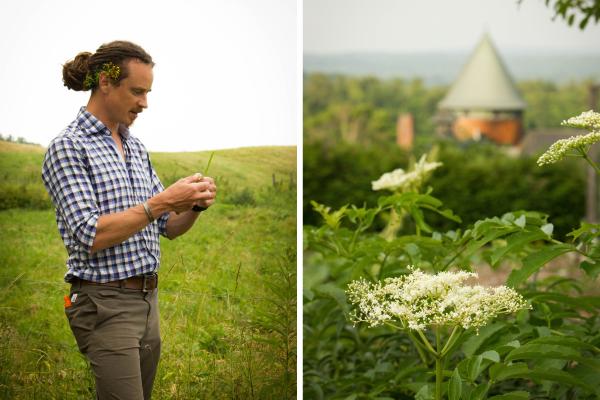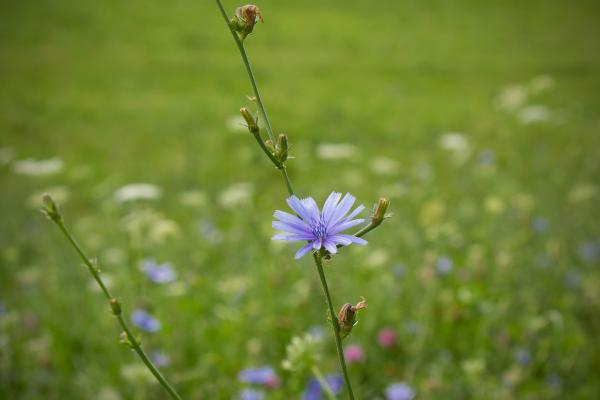"Weeds" and Medicine – Walking with an Herbalist
This summer and fall, we’ve partnered with Urban Moonshine and RAILYARD Apothecary to create evening Farm to Medicine Cabinet Plant Walks on the Farm. Each are 90-minute walking tours to find, identify, and hear the stories behind the often over-looked plants pricking our ankles in the fields and tucked under dense canopies in the forest. A certified herbalist leads each tour, and you’re apt to find and learn about different species each evening.
This month, Guido Masé, Chief Herbalist at Urban Moonshine, teacher, and author of The Wild Medicine Solution: Healing with Aromatic, Bitter and Tonic Plants took us up the hill beyond the Farm Barn to find plant-based medicines growing right under our noses. While he identified dozens of plants and recalled their uses, we chose a few common — and safe — plants to highlight from the “Weed Walk” with Guido:
Herbalist Guido Masé & elderflower blossoms above the Farm Barn
Elderflower
It’s a lucky thing that a plant with so many health benefits also happens to make a most delightful cordial! While the berries are celebrated morsels, the flowers are equally beneficial. Either dry or fresh (but without any stem), the flowers can be steeped into white wine or vodka (be sure to dilute with honey if you go the latter route). Mix this with club soda and a squeeze of lemon, and you have a cooling summer spritzer best enjoyed while horizontal in a hammock. While the pleasure of this drink is worthy enough of your effort, the tonic will help to relieve fevers and flu. If taken at nighttime, the drink can help to induce a sweat and expeditiously break a fever.
The berries themselves can be simmered and mixed with honey to form a viscous syrup. Allow the syrup to cool, and imbibe 1-2 tablespoons daily to prevent a flu (especially during months of temperature transition) or 3-4 tablespoons if the flu has already caught hold and you’re looking to speed up recovery.
Stinging Nettle
Although often considered a nuisance, the compounds that create the itchy, burning sensation you feel when brushing up against stinging nettle during a hike actually offer a range of health benefits. The nettle’s mineral-rich leaves supply an abundance of calcium, iron, and protein. As one of the first plants to leaf out after the long winter months, it is a much-adored spring green to sauté and stir into soups. If the leaves are heated or steeped into a tincture, the singing hairs are rendered harmless (no need to worry about a burning tingle traveling down your throat).
The formic acid and serotonin in these stinging hairs are powerful anti-allergens. Prepared as a fresh tincture, they offer relief to hay fever sufferers. If you thwack a bundle of fresh nettles on an area of the body afflicted with rheumatism or arthritis — called “urtication” — the hairs offer a numbing sensation without affecting fine motor function, offering welcome respite from the pain of those conditions. Many people compare urtication with bee sting treatments.
The seeds of stinging nettle can also be steeped to create a nutritive tonic that relieves stress and boosts energy. As one old story goes, unscrupulous horse dealers would feed older and feebler horses such a tonic. The result? A peppy horse with a shiny coat that would sell for a premium sum. By the time the effects of the tonic subsided and the age of the horse discovered, the scheming horse dealer was nowhere to be found.
The sky-colored chicory flower
Chicory
Chicory is the spindly, sun-loving plant with buds that open to reveal sky-blue flowers with raggedy-edged petals. A Native American myth tells the story of an eagle who flew so high that he bit off a piece of sky and brought the ripped off scrap back to Earth. This bit of sky became the chicory flower, whose colorful, frayed petals remind us of the eagle’s flight.
We’re most familiar with a hybridization of the chicory plant — radicchio, an endive-like plant that’s often added to salads. If you follow the long, slender chicory stems down to a leaf, you’ll find the recognizably bitter taste of radicchio. The Mediterranean dish horta is a potent leafy green salad of chicory, garlic, and olive oil meant to get digestive fluids moving and cool the body on a hot day by getting you to sweat a bit and rid excess heat.
Motherwort cutting
Motherwort
Surprisingly, motherwort is part of the mint family, but it looks vastly different from other members and has a very bitter taste, unlike the refreshing, sweet tastes of the mints in our gardens (or juleps!).
Motherwort is so named because the bulk of the plant’s medicinal properties are helpful to new mothers. If consumed habitually, a prepared tincture can act as an anti-anxiety and anti-stress therapy, especially with post-partum and menopausal women. Additionally, research has proven the chemicals within the plant relax and increase the elasticity of arteries, making for increased cardiovascular health.
To join us on August 20th for the next walk with Kate Elmer Westdjikr, sign up here. Look through the Adult Programs calendar to see listings for the full series. For more information on plant-based medicine, be sure to check out Urban Moonshine, RAILYARD Apothecary, and the Vermont Center for Integrative Herbalism.



